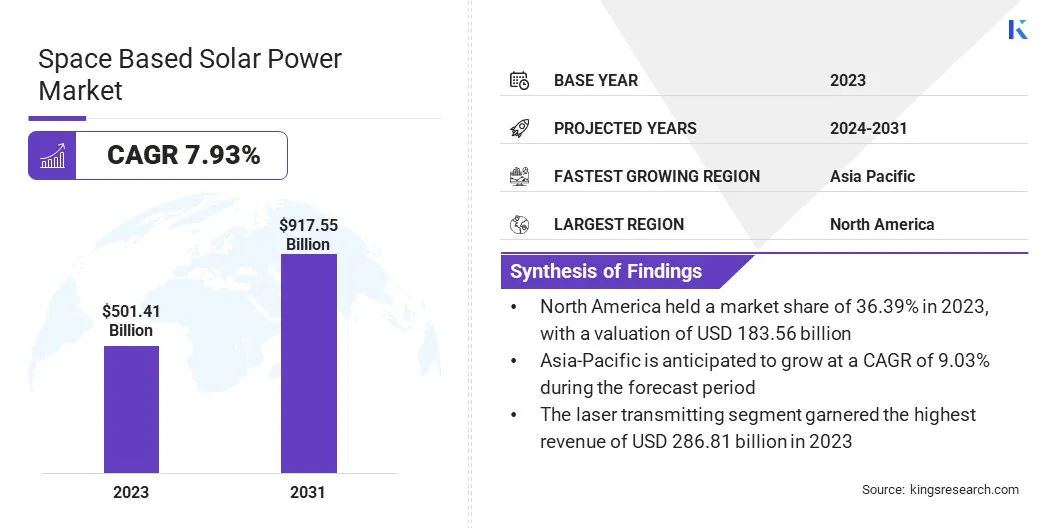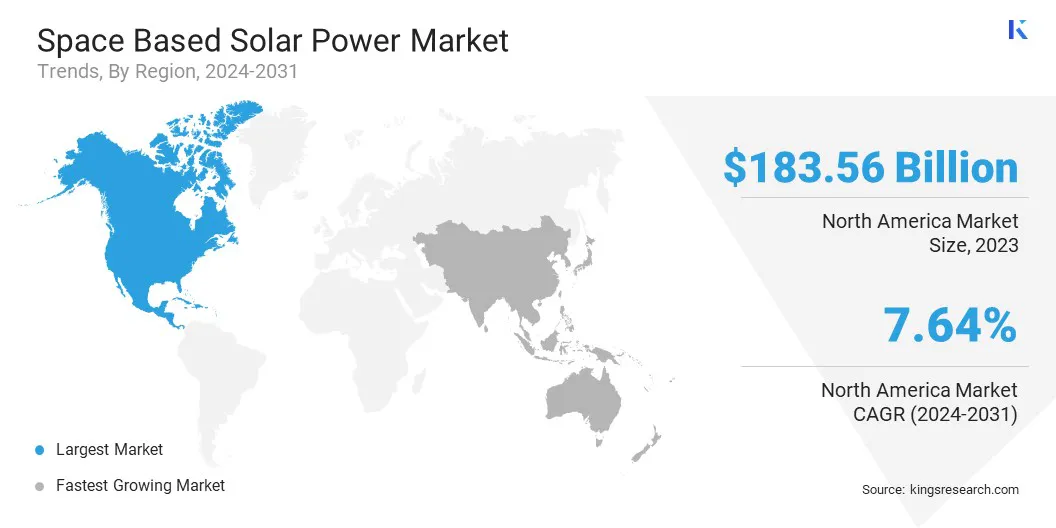Space Based Solar Power Market Size
Global Space Based Solar Power Market size was recorded at USD 501.41 billion in 2023, which is estimated to be at USD 537.68 billion in 2024 and projected to reach USD 917.55 billion by 2031, growing at a CAGR of 7.93% from 2024 to 2031. In the scope of work, the report includes solutions offered by companies such as Airborne, Boeing, Northrop Grumman, SpaceTech GmbH, VIRTUS SOLIS, AIRBUS, AZUR SPACE Solar Power GmbH, CESI S.p.A, EMROD, THALES ALENIA SPACE, and others.
The growth of the market is driven by advancements in space technology and the rising focus on renewable energy. This is due to its potential to provide clean and uninterrupted energy. The expansion of the market is further fueled by the increasing demand for sustainable energy solutions, coupled with rising concerns over climate change and the depletion of traditional energy sources.
Additionally, decreasing costs of space launch technologies and solar panel production contribute to the feasibility of space-based solar power projects. Furthermore, the ability to generate energy continuously, regardless of weather conditions or geographical location, enhances its appeal for both terrestrial and space applications.
The space-based solar power market is witnessing significant growth, majorly propelled by technological advancements and growing environmental concerns. This market involves the generation of solar power in space and its transmission to Earth or other space-based installations. It encompasses various components such as satellites, solar panels, power transmission systems, and ground stations.
Prominent players in this market include space agencies, aerospace companies, and other renewable energy firms.The space-based solar power market refers to the industry dedicated to the utilization of solar energy in space for transmission to Earth or other space-based platforms.
It encompasses the development, deployment, and operation of satellites equipped with solar panels to capture sunlight and convert it into electrical power. This energy is then transmitted via microwave or laser beams to receiving stations on Earth or other spacecraft. Key activities within this market include satellite design, launch operations, power transmission technologies, and the development of ground station infrastructure.

Analyst’s Review
The space-based solar power market is witnessing significant growth, primarily fueled by advancements in technology and increasing environmental consciousness. Manufacturers are focusing on enhancing satellite efficiency and power transmission systems. Emerging innovations, such as lightweight solar panels and in-orbit servicing capabilities, are reshaping the industry landscape.
To sustain this growth trajectory, manufacturers must prioritize R&D investments to develop cost-effective solutions and collaborate with the public sector to address regulatory challenges. Moreover, expanding market outreach and fostering strategic partnerships are likely to help companies capitalize on potential growth opportunities.
Space Based Solar Power Market Growth Factors
The growth of the space-based solar power market is propelled by the continuous advancements in space technology. Companies and research institutions are constantly innovating to improve the efficiency and cost-effectiveness of solar power generation in space. This includes the development of lightweight and durable solar panels, which enhance satellite design for optimal sunlight capture and improve power transmission technologies.
These advancements increase the feasibility of space-based solar power projects, thereby contributing to the overall growth of the space industry. Moreover, ongoing research and development initiatives foster collaboration among stakeholders, thus fostering innovation and expanding the market potential.
The high initial investment required for satellite deployment and infrastructure development pose a key challenge to market development, prompting manufacturers and other industry participants to develop strategic partnerships and investment collaborations. Pooling resources and expertise helps stakeholders mitigate individual financial burdens and share risks associated with project implementation.
Additionally, governments and international organizations are incentivizing private sector participation by providing grants, subsidies, and regulatory support. Fostering a conducive investment environment and promoting public-private partnerships enables market players to overcome financial barriers and accelerate growth trajectory.
Space Based Solar Power Market Trends
The increasing adoption of small satellites for solar power generation is an ongoing trend in the industry. Small satellites, also known as smallsats or CubeSats, offer cost-effective solutions for deploying solar power systems in space. These miniature satellites leverage advances in miniaturization technology, enabling efficient utilization of space and reduced launch costs.
Moreover, small satellites are being increasingly deployed in constellations, which enhances the flexibility and redundancy in power generation. This is further propelled by the growing interest from startups, research institutions, and governments in leveraging small satellite technology for various applications, including Earth observation, communications, and scientific research.
- According to India’s NEP14 policy, the country aims to shift approximately 66% of its energy generation to solar energy during FY22-32.
The emergence of in-orbit servicing capabilities with the increasing number of satellites in orbit has highlighted a growing need for maintenance, repair, and refueling services to extend their operational lifespan. In-orbit servicing missions enable the inspection, repair, and upgrade of satellites, including those equipped with solar power systems.
This trend is further aided by advancements in robotics, artificial intelligence, and autonomous spacecraft technologies, enabling precise and efficient servicing operations in space. Prolonging the lifespan of solar-powered satellites and enhancing their operational efficiency are significant contributions of in-orbit servicing to the growth and sustainability of the space-based solar power market.
- According to the UK government, as of 2024, there were approximately 9,000 satellites orbiting the planet, with the number anticipated to increase to 60,000 active satellites by 2030.
Segmentation Analysis
The global space based solar power market is segmented based on type, application, and geography.
By Type
Based on type, the market is categorized into microwave transmitting and laser transmitting. The laser transmitting segment led the market in 2023, reaching a valuation of USD 286.81 billion.
Laser technology offers higher efficiency and precision in transmitting solar power from space to Earth compared to microwave transmission. Additionally, laser beams can be focused more accurately, thereby reducing energy losses during transmission. The growing demand for reliable and high-power-density energy sources is further propelling the expansion of this segment.
Moreover, advancements in laser technology have led to cost reductions in manufacturing and deployment, making it a preferred choice for space-based solar power projects. These factors combined have contributed to the dominance of the laser transmitting segment in the market.
By Application
Based on application, the market is classified into electricity generation and space applications. The electricity generation segment is poised to witness significant growth, registering a CAGR of 8.13% through the forecast period (2024-2031). This remarkable growth is primarily boosted by the global rise in the demand for energy, resulting in an increasing emphasis on exploring sustainable and efficient energy sources.
Space-based solar power offers promising solutions to meet this surging demand, providing continuous and abundant solar energy regardless of geographical constraints. Additionally, advancements in satellite technology and power transmission systems are enhancing the feasibility and efficiency of electricity generation from space. Furthermore, the diversification of applications, including remote power generation and disaster relief, augments the expansion of this segment.
Space Based Solar Power Market Regional Analysis
Based on region, the global space based solar power market is classified into North America, Europe, Asia Pacific, MEA, and Latin America.

The North America Space Based Solar Power Market share stood around 36.39% in 2023 in the global market, with a valuation of USD 183.56 billion. This dominance is attributed to the region's advanced space technology infrastructure and expertise, which are supported by the presence of established aerospace companies and leading research institutions.
Additionally, supportive government policies and investments in renewable energy bolster the region's leading position in the global market. Moreover, a strong ecosystem of venture capital and private equity funding fosters an environment conducive to entrepreneurship and facilitates the development of space-based solar power projects.
Asia-Pacific is likely to observe significant growth, registering a CAGR of 9.03% over the forecast period. This rapid expansion is propelled by the region's burgeoning population and rapid industrialization, leading to an increased demand for sustainable energy solutions. Additionally, governments across Asia-Pacific are increasingly prioritizing renewable energy initiatives to address environmental concerns and reduce dependence on fossil fuels.
Furthermore, advancements in space technology and increased investments in space exploration programs propel the Asia-Pacific space-based solar power market growth. Supportive regulatory frameworks and growing public-private partnerships are strengthening Asia-Pacific's position as the fastest-growing region in the space-based solar power market.
- The Indian Space Research Organization (ISRO) is planning to launch approximately 50 satellites in the next five years for geospatial intelligence gathering.(2023-2028). This step highlights the rising development of space exploration in the APAC region.
Competitive Landscape
The global space based solar power market study will provide valuable insight with an emphasis on the fragmented nature of the industry. Prominent players are focusing on several key business strategies such as partnerships, mergers and acquisitions, product innovations, and joint ventures to expand their product portfolio and increase their market shares across different regions.
Manufacturers are adopting a range of strategic initiatives, including investments in R&D activities, the establishment of new manufacturing facilities, and supply chain optimization, to strengthen their market standing.
List of Key Companies in Space Based Solar Power Market
- Airborne
- Boeing
- Northrop Grumman
- SpaceTech GmbH
- VIRTUS SOLIS
- AIRBUS
- AZUR SPACE Solar Power GmbH
- CESI S.p.A
- EMROD
- THALES ALENIA SPACE
Key Industry Developments
- May 2024 (Partnership): SpaceTech delivered the initial four solar array panels for the European Space Agency's PLATO spacecraft mission to Thales Alenia Space. PLATO, a crucial part of ESA's Cosmic Vision program, aims to explore extrasolar planetary systems, with a major focus on terrestrial planets in habitable zones. This milestone follows SpaceTech's involvement in the EUCLID sunshield project, highlighting its continued collaboration with ESA.
- August 2023 (Partnership): CESI, in partnership with the Italian Space Agency (ASI), finalized a significant agreement valued at over 13 million euros to support the Space Factory project. This collaboration represents a strategic initiative for Italy, bolstering the national industrial supply chain's expertise in the space sector. With ASI's PNRR funds, CESI aims to enhance its solar cell production capacity for space satellites, integrate digitalized manufacturing processes, and adopt advanced monitoring technologies and machinery. CESI's solar cells, developed by using gallium arsenide and indium gallium phosphide, ensure high efficiency, meeting the stringent demands of space missions in both low earth orbit (LEO) and geostationary orbit (GEO).
The Global Space Based Solar Power Market is Segmented as:
By Type
- Microwave Transmitting
- Laser Transmitting
By Application
- Electricity Generation
- Space Applications
By Region
- North America
- Europe
- France
- U.K.
- Spain
- Germany
- Italy
- Russia
- Rest of Europe
- Asia-Pacific
- China
- Japan
- India
- South Korea
- Rest of Asia-Pacific
- Middle East & Africa
- GCC
- North Africa
- South Africa
- Rest of Middle East & Africa
- Latin America
- Brazil
- Argentina
- Rest of Latin America


